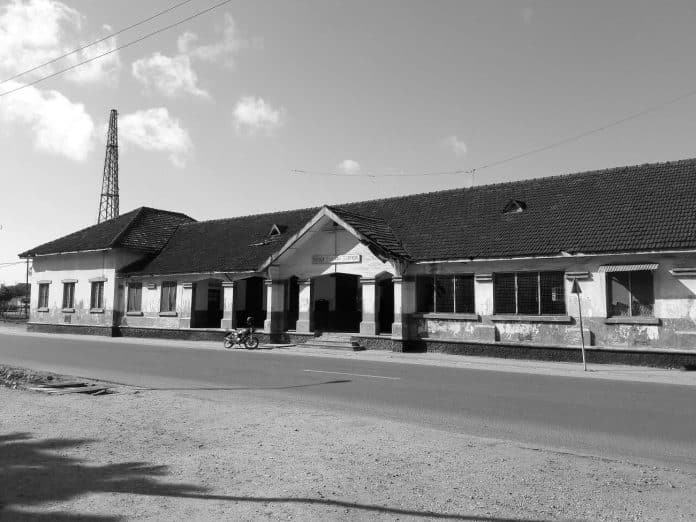Introduction to Mwambani Bay and its significance
Mwambani Bay, situated along the eastern coast of Tanzania, has long been a vital hub for the country’s maritime activities. As a strategic port location, Mwambani Bay has played a crucial role in facilitating the movement of goods, resources, and people, contributing significantly to Tanzania’s economic growth and development. However, in recent years, the growing demands of the nation’s expanding economy have necessitated the exploration of new opportunities to enhance the bay’s capabilities and connectivity.
Overview of the proposed extensions for Mwambani Bay

The Tanzanian government, in collaboration with various stakeholders, has unveiled an ambitious plan to extend and modernize the infrastructure of Mwambani Bay. This comprehensive initiative aims to transform the bay into a more efficient, versatile, and technologically advanced maritime hub, capable of meeting the evolving needs of the country’s thriving economy. The proposed extensions include:
- Expansion of the Port Facilities:
- Constructing additional deep-water berths to accommodate larger vessels
- Upgrading cargo handling equipment and storage facilities
- Implementing advanced cargo management systems and automation technologies
- Enhancing Rail Connectivity:
- Extending the existing railway network to directly link Mwambani Bay with key inland hubs
- Upgrading the rail infrastructure to support increased freight volumes and passenger transport
- Integrating multimodal transportation solutions for seamless cargo movement
- Developing Logistics and Industrial Zones:
- Establishing dedicated areas for warehousing, distribution centers, and value-added processing facilities
- Attracting investments in logistics-related industries and promoting the development of specialized services
- Improving Coastal and Inland Waterway Transportation:
- Dredging and maintaining navigable channels to accommodate larger vessels
- Constructing new jetties and berthing facilities for coastal and inland waterway transport
- Implementing efficient vessel management and traffic control systems
- Integrating Digital Technologies:
- Deploying smart port management systems for real-time monitoring and optimization
- Implementing blockchain-based solutions for secure and transparent cargo tracking
- Leveraging data analytics and artificial intelligence to enhance operational efficiency
Importance of rail and maritime infrastructure for Tanzania’s economy
The proposed extensions of Mwambani Bay are a strategic investment in Tanzania’s future, recognizing the vital role that rail and maritime infrastructure play in the country’s economic growth and development. As a predominantly agricultural and resource-rich nation, Tanzania’s ability to efficiently transport goods, raw materials, and finished products to both domestic and international markets is crucial. The enhanced rail and maritime connectivity provided by the Mwambani Bay extensions will:
- Improve the flow of exports, reducing logistical bottlenecks and enhancing the country’s competitiveness in global trade.
- Facilitate the import of essential commodities, machinery, and technology, supporting the development of various industries.
- Stimulate the growth of ancillary businesses and services, creating new employment opportunities and driving economic diversification.
- Strengthen Tanzania’s position as a regional hub for trade and logistics, attracting foreign investment and fostering regional economic integration.
Potential benefits of the proposed extensions
The proposed extensions of Mwambani Bay are expected to deliver a range of benefits that will positively impact Tanzania’s economic landscape. Some of the key advantages include:
- Enhanced Cargo Handling Capacity: The expansion of port facilities and the integration of advanced technologies will significantly increase the bay’s cargo handling capacity, enabling the efficient movement of larger volumes of goods.
- Improved Multimodal Connectivity: The enhanced rail and coastal/inland waterway connections will create a seamless multimodal transportation network, facilitating the efficient movement of goods across different modes of transport.
- Reduced Logistical Costs: The improved infrastructure and streamlined operations will lead to a reduction in overall logistics costs, making Tanzanian exports more competitive in global markets.
- Increased Foreign Investment: The modernized and efficient Mwambani Bay will attract increased foreign direct investment in various sectors, including logistics, manufacturing, and value-added processing.
- Job Creation and Economic Diversification: The development of the Mwambani Bay extensions will generate new employment opportunities, both directly and indirectly, while also fostering the growth of ancillary industries and services.
- Environmental Sustainability: The project’s commitment to sustainability, including the implementation of green technologies and environmentally-friendly practices, will contribute to Tanzania’s broader efforts to promote sustainable development.
Challenges and considerations in implementing the extensions
While the proposed extensions of Mwambani Bay hold immense potential, the project is not without its challenges and considerations. Some of the key factors that will need to be addressed include:
- Financing and Funding: The scale and complexity of the project will require significant financial resources, which may necessitate a combination of public and private sector investments, as well as innovative financing mechanisms.
- Stakeholder Coordination: Effective coordination and collaboration among various stakeholders, including government agencies, port authorities, logistics providers, and local communities, will be crucial for the successful implementation of the project.
- Environmental Impact Mitigation: The expansion and development of the bay’s infrastructure will need to be carefully planned and executed to minimize any adverse environmental impacts, ensuring the long-term sustainability of the project.
- Capacity Building and Skills Development: The successful operation and maintenance of the enhanced Mwambani Bay facilities will require the development of specialized skills and the training of a skilled workforce.
- Regulatory and Policy Frameworks: Ensuring that the necessary legal and regulatory frameworks are in place to support the project’s implementation and long-term operations will be a critical consideration.
Environmental impact assessment and sustainability measures
Recognizing the importance of environmental stewardship, the proposed extensions of Mwambani Bay have been designed with a strong emphasis on sustainability. The project will undergo a comprehensive environmental impact assessment to identify and mitigate any potential adverse effects on the local ecosystem. Some of the key sustainability measures being implemented include:
- Adoption of Green Technologies: The use of energy-efficient equipment, renewable energy sources, and environmentally-friendly cargo handling practices will minimize the project’s carbon footprint.
- Coastal and Marine Ecosystem Protection: Measures will be taken to preserve and protect the delicate coastal and marine habitats surrounding Mwambani Bay, ensuring the long-term ecological balance of the region.
- Waste Management and Pollution Control: Robust waste management systems and pollution control measures will be implemented to maintain the bay’s water quality and air purity.
- Biodiversity Conservation: The project will incorporate strategies to safeguard the local biodiversity, including the protection of endangered species and the restoration of natural habitats.
- Community Engagement and Awareness: Local communities will be actively engaged in the project’s planning and implementation, with a focus on promoting environmental awareness and fostering a sense of shared responsibility for the bay’s sustainability.
Stakeholder involvement and community impact
The successful implementation of the Mwambani Bay extensions will require the active participation and support of a diverse range of stakeholders. The project’s development team has placed a strong emphasis on inclusive and transparent engagement with the following key stakeholders:
- Government Agencies: Collaboration with relevant government ministries, regulatory bodies, and local authorities to ensure alignment with national policies and regulations.
- Port and Logistics Operators: Close coordination with existing port authorities, shipping companies, and logistics providers to integrate the new facilities seamlessly into the existing infrastructure.
- Local Communities: Engagement with neighboring communities to address their concerns, incorporate their feedback, and ensure that the project’s benefits are equitably distributed.
- Environmental and Civil Society Organizations: Consultation with environmental advocacy groups and community-based organizations to address sustainability and social impact considerations.
- Private Sector Investors: Attraction of private sector investments and partnerships to leverage expertise, resources, and innovative solutions.
By fostering inclusive stakeholder engagement, the Mwambani Bay extensions project aims to create a shared vision for the bay’s development, address community concerns, and ensure that the project’s benefits are widely distributed.
Funding and financing options for the project
The scale and complexity of the Mwambani Bay extensions project will require a comprehensive financing strategy that leverages a diverse range of funding sources. The Tanzanian government, in collaboration with various financial institutions and development partners, is exploring the following funding options:
- Public-Private Partnerships (PPPs): Establishing strategic partnerships with private sector entities to share the risks and benefits of the project’s development and operation.
- International Development Financing: Securing loans and grants from multilateral development banks, regional financial institutions, and international development agencies.
- Domestic Financing: Mobilizing resources from national development funds, state-owned enterprises, and private investors within Tanzania.
- Innovative Financing Mechanisms: Exploring alternative financing options, such as infrastructure bonds, project finance, and blended finance models, to leverage diverse funding sources.
- Phased Implementation: Adopting a phased approach to the project’s development, allowing for the gradual mobilization of resources and the optimization of funding sources over time.
The financing strategy will be designed to ensure the project’s financial sustainability, attract the necessary investments, and minimize the burden on the Tanzanian government’s budget.
Timeline and projected milestones for the extensions
The Mwambani Bay extensions project is envisioned as a multi-year undertaking, with a comprehensive timeline that outlines the key milestones and deliverables. The proposed timeline is as follows:
| Phase | Timeframe | Key Milestones |
| Planning and Design | 2023 – 2024 | – Completion of feasibility studies – Environmental and social impact assessments – Detailed engineering designs |
| Infrastructure Development | 2024 – 2027 | – Construction of new port facilities – Expansion of rail connectivity – Development of logistics and industrial zones |
| Operational Readiness | 2027 – 2028 | – Installation of advanced port management systems – Capacity building and skills development – Commencement of commercial operations |
| Optimization and Expansion | 2028 – 2030 | – Continuous improvement and optimization of operations – Expansion of cargo handling capacity – Integration of additional multimodal transportation solutions |
The project’s phased approach will allow for the gradual implementation and testing of the new facilities, ensuring that the Mwambani Bay extensions are delivered in a timely and efficient manner, meeting the evolving needs of Tanzania’s growing economy.
Conclusion: The future outlook for Mwambani Bay and Tanzania’s rail and maritime industry
The proposed extensions of Mwambani Bay represent a transformative vision for Tanzania’s rail and maritime infrastructure, positioning the country for long-term economic prosperity and global competitiveness. By enhancing the bay’s cargo handling capabilities, improving multimodal connectivity, and fostering sustainable development, this ambitious project holds the potential to unlock new avenues for growth and innovation across various sectors.
As Tanzania continues to harness the power of its natural resources and agricultural wealth, the Mwambani Bay extensions will serve as a vital conduit, seamlessly connecting the nation’s economic hubs and facilitating the efficient movement of goods, both domestically and internationally. This strategic investment in the country’s transportation infrastructure will not only bolster Tanzania’s position as a regional logistics hub but also contribute to the broader economic diversification and sustainable development of the nation.
For more articles related to Railway and train travel Tanzania, click here!

































